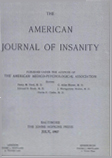Abstract
The number of the insane in asylums and hospitals has been on the increase during the past several decades at a more rapid rate than the general population.
In the United States there were in 1880, 86.5 institution inmates per 100,000 of the general population; by 1910 the number had risen to 232.0.
At any given time the number differs widely in the various states.
In 1910 there were in the state of Oklahoma 67.0 institution inmates per 100,000 of the general population, while in the state of Massachusetts there were 413.4.
To attempt an analysis of conditions which have, independently of any eugenic movement, determined in the various states of the Union the extent of the practice of segregating neuropathic persons in special institutions is the main object of this study.
The number of neuropathic persons in institutions per 100,000 of the general population, in the United States as a whole at different times, and in the various states at any one time, is in direct correlation with the following factors: (1) per capita wealth production; (2) percentage of urban population; (3) accessibility of institutions; and (4) intra-mural conditions, as indicated by per capita cost of maintenance in institutions.
It is in reverse correlation with the factor of percentage of illiteracy.
The controlling influence of the factor of per capita wealth production would seem to be not inevitable, in the nature of things, but rather due to a fallacious financial policy generally in vogue.
The benefits of segregation are to be felt not only by the present generation, but also, and probably to a greater extent, by generations to come; it would seem fair, therefore, that a part of the large expense of segregation should be borne by them.
Every state could easily double or treble its facilities for segregation with the aid of bond issues and thus make funds that are now expended for construction available for the maintenance of the increased number of its wards.
As regards the factor of percentage of urban population, the stream of migration from country to city, which is so characteristic of modern times and which has been by many greatly deplored, seems, from the eugenic standpoint, to have a beneficial aspect; it is undoubtedly a cause of the almost universal rise in prices of agricultural products and thus a growing influence for the elevation of rural standards.
An undue prevalence of illiteracy in a community is a cacogenic factor.
Conversely, money spent for public education is spent, at least indirectly or in ultimate effect, in an eugenic cause.
The factors of accessibility of institutions and intra-mural conditions are apt to work against each other in a peculiar way: a general policy could hardly be formulated that would best govern them.
The opinion is offered that no institution is sufficiently accessible to its population districts which is not within 50 miles of them.
In some cases a number of small institutions, not too far apart, and without special restrictions as to classes of patients admitted, may be preferred in spite of high expense of maintenance. In other cases, especially in densely populated districts, a smaller number of large institutions, each organized for the care of special classes of patients, may be found more economical and in every way more desirable.
A comparison of the laws of the various states reveals the general fact that those states which have the greatest numbers of neuropathic persons in institutions in proportion to their general population have also the simplest legal procedures for the admission of patients, and, vice versa, those which have the least numbers have also the most cumbersome legal procedures and the greatest number of obstacles and restrictions.
A state needs but to provide ample, well conducted and readily accessible institutions; for the rest, contrary to the commonly expressed notion, forced segregation is far less effective than free or voluntary segregation. The interests of eugenics are best served where detention by law is reduced to a minimum.
It is held that in no case could forced segregation be advocated with propriety and with social benefit merely because a diagnosis of some neuropathic condition has been made and on eugenic grounds alone: in the absence of a need of protection for society, or of an appeal for aid or for medical treatment, indications for segregation do not exist.
This point of view would eliminate the practically unanswerable question in eugenics, What persons should be selected for segregation? The selection is made automatically according to the standards and exactions of every environment.
[See table in the PDF file]

